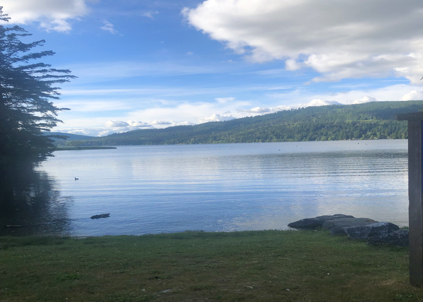Enoch J. Ledet guest writes. Enoch is retired from a career in petrochemical research and marketing. He has lived the past 16 years in Sudden Valley, on Lake Whatcom.
- - -
Note to reader: This article is a summary of his full report. The full report is a pdf and is linked at the bottom of this summary article.
- - -
Lake Whatcom water users, tax payers, and new storm water district customers are being required to fund the construction of Best Management Practice (BMP) storm water filters to trap and remove external phosphorous before it enters the lake. BMP filter construction is an integral part of the Department of Ecology’s Total Mass Daily Load (TMDL) on phosphorous (P) and bacteria. DOE estimates it will have to filter/remove 3,140 lbs. of phosphorous from stormwater runoff to bring the lake back to 2002-3 Dissolved Oxygen (DO) concentrations. DOE has used data from WWU researchers stating that phosphorous is the main cause for low dissolved oxygen in the lake. In 1998, due to Low DO in Basins 1 and 2, the EPA placed Lake Whatcom on its 303d list of polluted waters.
Tax and fee payers are being assessed a total of $100 million over the next 50 years to pay for implementation and maintenance of these BMP storm water filters. The new storm water district fee will collect an estimated $41 million ($820,000 x 50 years) of the total $100 million from Lake Whatcom water users outside the City of Bellingham. Bellingham tax payers have already been assessed a stormwater tax/fee. However, data from 2019 shows that in the last 12 years of operation, BMP filters have only prevented 436 lbs. of phosphorous, (out of 3,140 lbs.,) from entering the lake. This is an average of 36.3 lbs. of phosphorous per year. If we are able to capture the anticipated 3,140 lbs. of phosphorous, it will have been at a cost of $32,000 per pound.
Research indicates that the best BMP filters remove only 50% of external phosphorous (EP) and don’t address the internal phosphorous (IP) already present in lake sediment at all. This internal phosphorous recycles annually, causing algae and blue-green bacteria. The bacterial degradation of the algae is one cause of oxygen depletion, enabling anaerobic biochemical reactions to occur. This repeating cycle of “bloom and bust” negatively impacts lake water quality and increases drinking water treatment costs.
Currently, we are only addressing the external phosphorous input into Lake Whatcom. There are two problems with this approach. 1) Not all “EP pathways” into the lake have been identified; i.e., point sources such as streams, creeks, ditches, etc., and non-point sources such as developed or undeveloped land near the lake; and 2) even the best BMP filters for removing EP can not be used to treat all EP pathways into the lake. Naturally, filtering will not address the Internal Phosphorous (IP) already present in lake sediment.
Since all EP pathways (point source and non-point source) flow into the lake, and BMPs have to be fortified with alum/aluminum salts to increase BMP filter efficiencies, why not save money (operations and maintenance construction costs), as well as implementation time, and add alum directly to lake waters to bind EP inflow pathways into the lake? Alum will also bind IP in the water column and sediments already in the lake. Numerous case studies show that in-lake treatment of internal phosphorus (IP), using alum (aluminum sulfate) is 50 times more effective/efficient than using external BMPs and is one-tenth the cost.
Wisconsin studies on alum addition to lakes to control phosphorus and mitigate algae/phytoplankton growth also show that it is both cost effective and safe to use. Alum is and has been safely used in drinking water treatment plants, including Bellingham’s water treatment plant, all over the United States, and in Europe.
Bellingham’s Public Works Department could run a three-year beta test in Basin 1 to evaluate whether alum-addition removes enough phosphorus and algae to restore sufficient oxygen to provide healthy fish habitat and remove DOE’s determination of “polluted waters” for our lake. WWU and a third party environmental lab would provide analysis on: alum-addition effectiveness and efficiency of binding and removing TP, control and management of phytoplankton growth/reproduction, and verify or refute the DOE/WWU statement that phosphorus is the main cause of low DO in Basin 1
My causal analysis of low dispersed oxygen in Lake Whatcom, and research over the last 15 years into solutions for DO-impaired lakes and drinking water reservoirs, has led to the conclusion/proposal that DOE and CoB will need a combination of solutions to manage not only Total Phosphorous (external stormwater phosphorus and internal water column and sediment phosphorus) as well as phytoplankton, and supplemental Oxygen. Using a combined, holistic, in-lake solution can save local taxpayers $50 – $80 million over the next 50 years and be implemented within two years. Measurable improvements in Lake Whatcom water quality will be realized in 10 years vs. the 50-year implementation time for current Total Mass Daily Load phosphorus solution focused on managing EP only.



Comments by Readers
Dianne Foster
Aug 22, 2020What most of us have been working for is stopping development on the lake - that would be the most effective. But of course after decades of county council doing nothing (except a few purchase of development rights), now it is overdeveloped, and we the taxpayers have to clean it up…..